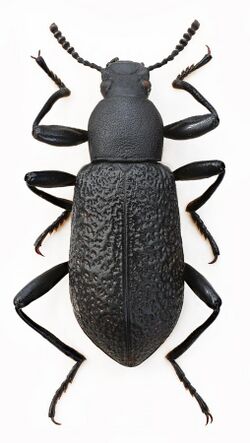Biology:Upis ceramboides
| Upis ceramboides | |
|---|---|

| |
| Scientific classification | |
| Domain: | Eukaryota |
| Kingdom: | Animalia |
| Phylum: | Arthropoda |
| Class: | Insecta |
| Order: | Coleoptera |
| Infraorder: | Cucujiformia |
| Family: | Tenebrionidae |
| Genus: | Upis |
| Species: | U. ceramboides
|
| Binomial name | |
| Upis ceramboides | |
Upis ceramboides is a species of beetle, one of many wood-living insects that benefit from forest fires. It often occurs in quantities below the bark on the fire-damaged birches, but can sometimes be seen on other deciduous trees such as willow and aspen. The larvae thrive in the inner bark which is rich in mycelia, and in the sapwood. They develop into pupae during the summer months under the bark, and they develop over two or three years. The following spring they reproduce themselves.
It has over the years have disappeared from southern Sweden and is now only locally in the Norrland coast (Västerbotten and Norrbotten) as well as Canada and Alaska.[1] The reason for the species' decline is probably the lack of fire-damaged forests and birch, and the modern forestry practices. Upis ceramboides is considered "vulnerable" in terms of species survival. In Vindeln municipality it is called köksskörven, because it occurs indoors when burning firewood in winter.[2][3][4]
The species' survival at temperatures well below freezing are attributed to the xylomannan non-protein antifreeze molecule (polysaccharide and a fatty acid)[5][6][7] as well as the sugar-alcohol, threitol.[8]
Other notable freeze-tolerant animals include the fly Polypedilum vanderplanki and the beetle Cucujus clavipes puniceus.[1]
References
- ↑ 1.0 1.1 Ned Rozell (Oct 2007). "Alaska beetles survive 'unearthly' temperatures". http://www.sitnews.us/1007news/101807/101807_akscience.html.
- ↑ "Sweden Entomological Society - Large black beetle". http://www.sef.nu/landskapsinsekter/upis.htm.
- ↑ "Darkling Beetle - Upis ceramboides, Canada". http://bugguide.net/node/view/235819.
- ↑ "Images of Upis ceramboides". http://www.zin.ru/ANIMALIA/COLEOPTERA/eng/upiscer.htm.
- ↑ "Synthetic study and structural analysis of the antifreeze agent xylomannan from Upis ceramboides". Journal of the American Chemical Society 133 (48): 19524–19535. 2011. doi:10.1021/ja208528c. PMID 22029271.
- ↑ "Synthesis and structural verification of the xylomannan antifreeze substance from the freeze-tolerant Alaskan beetle Upis ceramboides". Journal of Organic Chemistry 76 (21): 8611–8620. 2011. doi:10.1021/jo201780e. PMID 21955117.
- ↑ Walters KR Jr; Serianni AS; Sformo T; Barnes BM; Duman JG (2009). "A nonprotein thermal hysteresis-producing xylomannan antifreeze in the freeze-tolerant Alaskan beetle Upis ceramboides". Proceedings of the National Academy of Sciences 106 (48): 20210–20215. doi:10.1073/pnas.0909872106. PMID 19934038.
- ↑ Walters KR Jr; Pan Q; Serianni AS; Duman JG (2009). "Cryoprotectant biosynthesis and the selective accumulation of threitol in the freeze-tolerant Alaskan beetle, Upis ceramboides". Journal of Biological Chemistry 284 (25): 16822–16831. doi:10.1074/jbc.M109.013870. PMID 19403530.
Wikidata ☰ Q7898325 entry
 |

